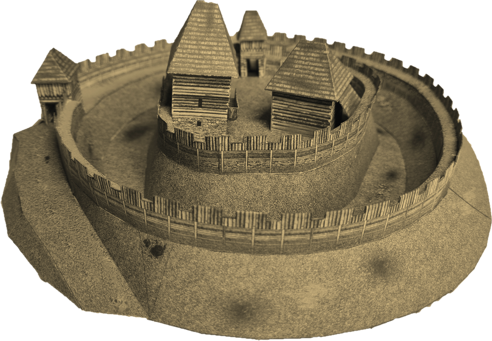

ABOUT ŠTANDL CASTLE
This model shows the historical reconstruction of Štandl Castle, located in the Czech Republic near Frýdek-Místek town, on a hill 349 mts above sea level, surrounded by rivers Olešná and Ostravice. There used to be a fort named Lipina nearby in the early medieval times. This settlement was populated since the prehistoric times thanks to its location, providing both protection from enemies and floods and hunting opportunities.
We have only scarce resources of information. The foundation stone was laid around 1250 by an unknown owner. The castle served as protection of the Amber Path (an ancient trade route leading across Europe, from Southern Italy to the Baltic Sea), as well as protecting the borders between Moravia (belonging to the Roman Empire then) and Polonia (today´s Poland). There are no documents about the castle in the archives. However, we know this place was connected with Arnold de Hugeswage and his son Frank. These may be the founders of the castle. There is another theory though – a bronze forging with a coat of arms was found during an archaeological research, suggesting the origin of the castle may be connected with Bruno of Schanenburg, the Bishop of Olomouc. The Bishop might have sent the Deblín clan (most probably Artlem of Deblín) and his military troops to build a fortress here when Ostravice river became the border place between Moravia and Upper Silesia. The border was agreed between the Czech King Přemysl Otakar II and the Polish duke Wladyslaw Piast in 1256. The Olomouc bishop had a chain of fortresses built along the river banks. Unfortunately, most of them were built of wood and don´t exist anymore. There is a document stating taxes were paid in this area from 1257.
At the end of 13th Century, the Stang od Sachsen clan occupied Štandl while the Bishop´s troops moved to a more representative place called Brušperk. The Stangs started building the nearby Lipina castle. Both castles probably served and as a temporary accommodation site for passing trade caravans during flood season.
We have no information about what happened in the castle in 14th Century. A much bigger stone castle named Hukvaldy was built nearby and all important events happened there. The archaeological research suggests there were two major fires in Štandl and all the wooden parts were destroyed. A new tower was built here in 1327, but then the countries´ borderline moved again and there was no point to keep the guards here. A new stone castle was built in the nearby town Frýdek.
Today, only a few stones and ditches are left. You can walk along a forest path from Frýdek-Místek town or from Lysůvky village to see the site. There are several legends about this place – some say there are chests of gold buried underground. There is also a theory saying the famous warrior Attila the Hun might be buried here.
ARCHITECTURE OF THE CASTLE
The only real remain of the castle is a rectangular room´s base with dimensions 4.6x5.8mts, walls made of stone, with a clay floor. They did not use grout back then, so the stones were just laid on top of each other and coated with clay. Above this basement, there was a wooden room and above this room, there was another wooden construction supporting the roof. The roof was made of shingles – a large number of iron nails used in shingle roofs found here. There was another building, most probably with an entrance into a secret underground corridor leading out of the castle and used for a safe evacuation. There might have been horse stables as well, but there are no remains left. The inner yard was protected by a wall built of stone and wood. This wall was surrounded by a trench and outer palisade walls.
Texts: Simona Čechalová
 Štandl Castle 01 |
 Štandl Castle 02 |
 Štandl Castle 03 |
 Štandl Castle 04 |
 Štandl Castle 05 |
 Štandl Castle 06 |
You can order in our e-shop.
Back


